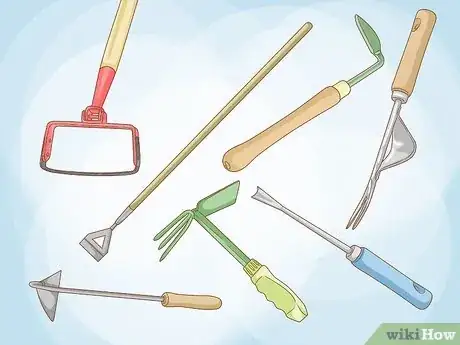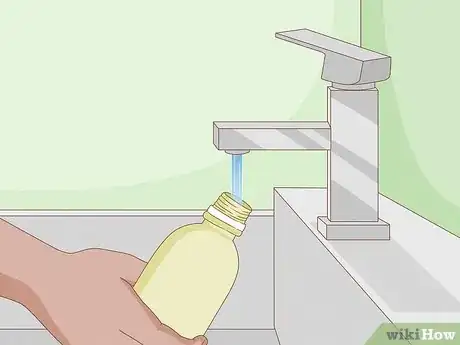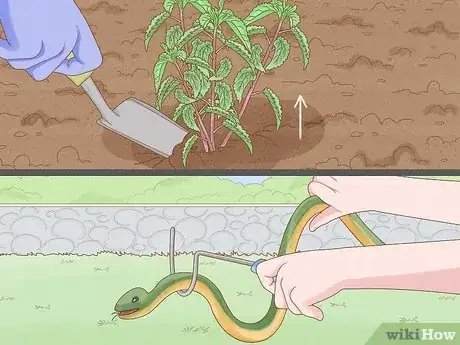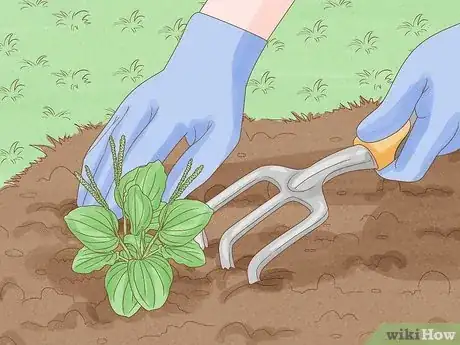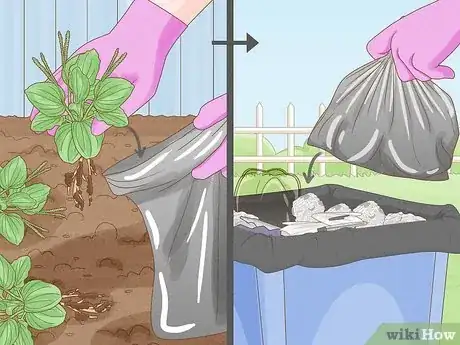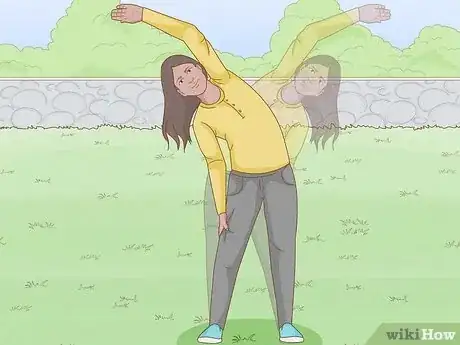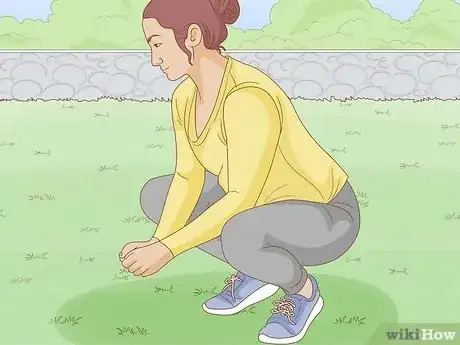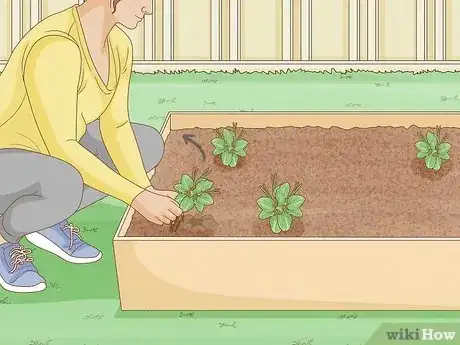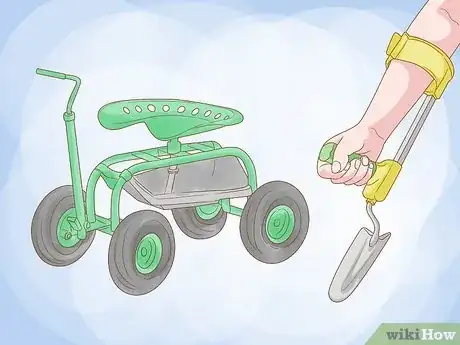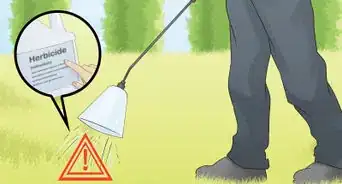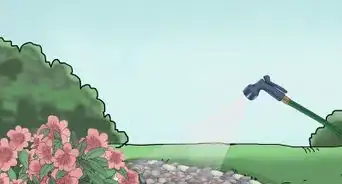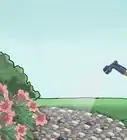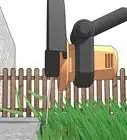This article was co-authored by Lauren Kurtz. Lauren Kurtz is a Naturalist and Horticultural Specialist. Lauren has worked for Aurora, Colorado managing the Water-Wise Garden at Aurora Municipal Center for the Water Conservation Department. She earned a BA in Environmental and Sustainability Studies from Western Michigan University in 2014.
There are 11 references cited in this article, which can be found at the bottom of the page.
wikiHow marks an article as reader-approved once it receives enough positive feedback. In this case, several readers have written to tell us that this article was helpful to them, earning it our reader-approved status.
This article has been viewed 212,107 times.
Pulling weeds is an everyday activity for most gardeners. You can try all kinds of things to prevent weeds from cropping up such as mulching or using cover crops. In the end, you will end up having to pull weeds from your garden beds throughout the season. Pulling up weeds involves identifying the weeds you want to remove from the garden bed, loosening the soil around the weed, and pulling the entire weed up from the root.[1] To make this onerous task a little easier, you can use some nice gardening gloves, short or long handled weeding tools and other garden aids such as benches or kneepads.[2] Using the right tools and approach, pulling up weeds does not have to be as backbreaking as it sounds.
Steps
Preparing to Pull Weeds
-
1
-
2Find a pair of gardening gloves. Try to find gardening gloves with some kind of wrist closure such a Velcro band that can be tightened around the wrist. In general, you want to find a pair of gardening gloves that are comfortable and reasonably durable.[5]
- Use whatever pair of gardening gloves you have in your shed. Any pair will do for weeding, but it is preferable to have a pair with wrist closure.
- Purchase a new pair of gardening gloves from a home and garden center. Look for a pair that fits your hands and has some design features such as reinforced fingertips, double stitching, and wrist closure.[6]
- If you're weeding abrasive or pointy weeds, like thistle, get gloves made of leather or another thick material.
Advertisement -
3Pick up your weeding tools. Weeding tools are great if you want to keep your hands clean or if you are weeding in an area that is particularly tough, such as an area with hard soil, a crack in the pavement, or a high concentration of weeds. Weeding tools are also great if you want to save some energy, since using your hands to weed can be quite exhausting. You should go to the shed and pick up the weeding tools you need for your job. If you are weeding in a tightly planted area and will be working on your knees, you will need a short handled weeding tool. If you are weeding a large area of the garden and plan to complete the weeding standing up, you will need a long handled weeding tool.[7] If you do not have the right weeding tools for your job, you may need to visit your local home and garden center to purchase an appropriate weeding tool.
- If you are buying a new weeding tool, you may want to examine the sharpness of the tool, whether it is made with good materials (for example, a stainless steel blade), and whether or not it will work for the most common weeding tasks in your garden. You should also consider whether you can comfortably grip the tool in your hands.[8]
- The Japanese farmer's knife is a type of short handled weeding tool that can be used to stab and saw through roots and pull up tough weeds.[9]
- The Cape Cod weeder is a type of short handled weeding tool that is especially good for weeding in tight spaces of your garden.[10]
- The radius pro weeder is a long handled weeder that has a circular handle, which is great for people with arthritis or wrist troubles.[11]
- The weed dragon garden torch cooks your weeds to eliminate them for good. It emits a flame that cooks the weeds and eventually kills them, since they are then unable to take in nutrients.[12]
-
4Protect yourself from the sun. You should put on a hat and some sunscreen lotion. Weeding is exhausting work that usually involves exposure to the sun, so you will need to protect your face, neck and any other exposed parts of your body.
- Use a sunscreen with SPF 15 or higher. If you have fair skin, you should be using at least SPF 30. The SPF number tells you how well the sunscreen protects you from burning.[13]
- Choose a sunscreen that has good water or sweat resistance. Weeding is tough work that involves some sweating, so you should make sure your sunscreen can stand up to the job.[14]
- If you are weeding in a greenhouse or indoors, you can skip this step.
-
5Fill up your water bottle. You will need to stay hydrated while weeding, so fill up a water bottle or two. You will need to drink water before, during, and after weeding in order to keep hydrated. Keeping hydrated will prevent heat stroke due to prolonged exposure to the sun while you are gardening.[15]
-
6Look for any garden hazards and remove them. If there are hoses left lying about, put them aside so you don't trip on them while weeding. If there are pitchforks lying on the ground, remove them so you don't trip on them. Remove any such hazards so that you can weed in peace.
- If there is stinging nettle in the area, take a note of where it is located so you can avoid being stung.
- If there are poisonous snakes in your area, take a look to make sure there aren't any in your garden. On hot days, watch out for snakes in cool and shady areas. In general, snakes will be attracted to any area of your garden that is cool, moist and cavernous.[16]
- Check to make sure you know where the first aid kit is located in your garden or house, so that you can get it if you get a scrape or cut while weeding. Although weeding is not generally a dangerous activity, it is good to be prepared just in case.
Identifying, Loosening, and Removing Weeds
-
1Identify the weeds you want to remove. Walk around the garden bed you plan to weed and identify the areas that need to be weeded. While you are surveying the bed, take a close look to identify edible weeds that you may want to keep such as dandelion, amaranth, plantain or lamb's quarters.[17] Once you have an idea of what you want to pull up and what you want to leave, start weeding the bed.
- Consider whether you want to harvest edible weeds to eat later. Many edible plants are commonly seen as weeds but are great additions to salads and stir fries. For instance, dandelions are commonly seen as a weed but are actually a very tasty vegetable that can be added to salads, stir fries, and soups.[18] You may not have planted these edible plants yourself, but they can be desirable nonetheless. Pull them up and store them in a mason jar in your fridge.
-
2Kneel down or stand above the weed you want to remove. If you are using a short handled weeding tool or your hands, kneel down in the bed and get ready to pull up the weed. If you are using a long handled weeding tool, you can position yourself standing directly above the weed you want to remove.
- Use caution when kneeling. Don't kneel on concrete or rocks without knee pads or some other cushion.
-
3Loosen the soil where the stem of the weed meets the top of the garden bed. If you are working in wet soil, it will be quite easy to loosen up this soil. If you are working in dry conditions, you may need to work a little harder to loosen it up.[19] Stab at the soil with your weeding tool and break up any large clumps of soil. Gradually break up the soil around the weed so that you can access the taproot with your hands or weeding tool.
-
4Grab the taproot or main root of the weed with your hand or weeding tool. It is important to grab as much of the root as possible, otherwise the weed will simply grow back.[20]
-
5Pull up the weed. Using your weeding tool or your hand, pull the weed out of the garden bed. Whether you use your hands or a garden tool is partly a matter of personal preference. For example, some people prefer to wear garden gloves and use a weeding tool in order to keep their hands clean. However, many gardeners enjoy the feeling of getting their hands dirty and are happy to use their hands. Grip the bottom of the weed tightly and pull it sharply out of the ground. Try to pull the whole weed out of the garden in one piece by pulling straight up rather than at an angle, so you don't have to repeat this step. Repeat the process until you have a weed-free garden
- If you are unsuccessful in pulling up the roots of the weed, you can use your weeding tool to dig a little deeper and pull up any remaining roots.
- If you have trouble pulling up the taproot, you can use your weeding tool to cut deeper into the root system.
-
6Collect the weeds and dispose of them. If you have a compost pile, you can put the weeds in your compost bin. You can use the composted soil next year. If you have a curbside lawn waste program, you can put your weeds in a bag and dispose of them on the appropriate day for lawn waste pickup.
- If you compost your weeds, avoid putting weeds that can re-root themselves easily into your compost. Throw weeds in the trash if this is a concern.
- Avoid disposing of your weeds on public lands. Many weeds are invasive species and will have a damaging impact on public parks and conservation areas.
Being Friendly to Your Back While Pulling Weeds
-
1Stretch before you start weeding. Fifteen minutes prior to weeding, you should do a stretching routine to loosen up your muscles and prepare your body for the task. Start by doing a lateral stretch to loosen up your back and shoulders, then stand forward and bend to loosen up chest, legs, back and shoulders. You can finish your routine with a goddess pose to loosen up the hips.
- The lateral stretch is great for your back and shoulders. Standing with your feet together and slightly bent, place your left hand on your hip and extend your right harm overhead. Lean to the left while keeping your body aligned. Then, repeat the stretch on your other side.
- To complete the forward bend: lean forward over your knees with your arms behind your back and your fingers interlaced. Relax your neck and shoulders.
- To complete the goddess pose: lie on the floor with your knees bent and your feet touching. Allow your knees to lower to the floor. You can put your arms above your head at the same time, with your fingers touching.
-
2Sit with your legs bent, parallel and one leg slightly in front of the other. Sit with your back straight. Your legs should be straight in front of you, parallel to one another and slightly bent. Try to anchor your sitting bones into the ground and keep your back perfectly straight. This will help you relax, conserve energy and avoid back pain.
- If you have bad knees or a bad back, you may prefer to sit on a gardening chair or a gardening stool.
-
3Maintain a straight back while weeding from a standing position. If you are weeding with a long handled weeding tool while standing, it is best to bend from the hips instead of the back. This will help you avoid back pain and conserve energy while weeding.
-
4Install raised beds to avoid back pain while weeding. If you find you experience a lot of back pain during weeding and other daily gardening tasks, you may consider installing raised beds. A raised garden bed elevates the height of your garden so you don't need to lower your body as much when weeding.
- Make your own raised garden bed. You can use logs, bricks, branches, cedar, sandbags and other common materials to make your own raised beds. If you are less inclined to do it yourself, you can also purchase a raised garden bed from many home and garden centers.[21]
-
5Purchase ergonomic gardening aids to ease back pain. You might consider buying some kneepads or a garden seat to ease the daily task of weeding.
- There are a wide range of supports such as kneepads, benches, seats and combination kneepads and benches. Look for a support that fits your body and price range. These products range from $35 to $90.[22]
Expert Q&A
Did you know you can get expert answers for this article?
Unlock expert answers by supporting wikiHow
-
QuestionHow do you dispose of weeds?
 Lauren KurtzLauren Kurtz is a Naturalist and Horticultural Specialist. Lauren has worked for Aurora, Colorado managing the Water-Wise Garden at Aurora Municipal Center for the Water Conservation Department. She earned a BA in Environmental and Sustainability Studies from Western Michigan University in 2014.
Lauren KurtzLauren Kurtz is a Naturalist and Horticultural Specialist. Lauren has worked for Aurora, Colorado managing the Water-Wise Garden at Aurora Municipal Center for the Water Conservation Department. She earned a BA in Environmental and Sustainability Studies from Western Michigan University in 2014.
Professional Gardener Bag weeds and put them in the garbage. Some people have a brush or compost pile on their property where they dump yard debris. Use caution when disposing of weeds in your yard because weeds already gone to seed can contaminate your pile with weeds. Some weeds can continue to grow from cuttings placed in a compost pile.
Bag weeds and put them in the garbage. Some people have a brush or compost pile on their property where they dump yard debris. Use caution when disposing of weeds in your yard because weeds already gone to seed can contaminate your pile with weeds. Some weeds can continue to grow from cuttings placed in a compost pile. -
QuestionHow do I prevent weeds from growing between pavers?
 Lauren KurtzLauren Kurtz is a Naturalist and Horticultural Specialist. Lauren has worked for Aurora, Colorado managing the Water-Wise Garden at Aurora Municipal Center for the Water Conservation Department. She earned a BA in Environmental and Sustainability Studies from Western Michigan University in 2014.
Lauren KurtzLauren Kurtz is a Naturalist and Horticultural Specialist. Lauren has worked for Aurora, Colorado managing the Water-Wise Garden at Aurora Municipal Center for the Water Conservation Department. She earned a BA in Environmental and Sustainability Studies from Western Michigan University in 2014.
Professional Gardener
-
QuestionIf I dislodge the weed body and roots from the ground with a hoe or similar tool, can I just leave them on the ground (will they dry up?) or do I have to remove them?
 Lauren KurtzLauren Kurtz is a Naturalist and Horticultural Specialist. Lauren has worked for Aurora, Colorado managing the Water-Wise Garden at Aurora Municipal Center for the Water Conservation Department. She earned a BA in Environmental and Sustainability Studies from Western Michigan University in 2014.
Lauren KurtzLauren Kurtz is a Naturalist and Horticultural Specialist. Lauren has worked for Aurora, Colorado managing the Water-Wise Garden at Aurora Municipal Center for the Water Conservation Department. She earned a BA in Environmental and Sustainability Studies from Western Michigan University in 2014.
Professional Gardener
Warnings
- Be careful not to damage desirable plants while pulling the weeds.⧼thumbs_response⧽
Things You'll Need
- Gloves
- Comfortable attire
- Shovel or other sharp pointed garden tool
References
- ↑ http://www.almanac.com/content/weed-control-techniques
- ↑ http://www.huffingtonpost.com/jim-t-miller/ergonomic-tools-that-can_b_5599020.html
- ↑ http://www.finegardening.com/six-tips-effective-weed-control
- ↑ https://dengarden.com/gardening/How-to-Prevent-Weeds
- ↑ http://gardeningproductsreview.com/best-gardening-gloves/
- ↑ http://gardeningproductsreview.com/best-gardening-gloves/
- ↑ http://gardeningproductsreview.com/best-weeding-tools/
- ↑ http://gardeningproductsreview.com/best-weeding-tools/
- ↑ http://gardeningproductsreview.com/best-weeding-tools/
- ↑ http://gardeningproductsreview.com/best-weeding-tools/
- ↑ http://gardeningproductsreview.com/best-weeding-tools/
- ↑ http://gardeningproductsreview.com/best-weeding-tools/
- ↑ http://www.webmd.com/beauty/features/whats-best-sunscreen#1
- ↑ http://www.webmd.com/beauty/features/whats-best-sunscreen#1
- ↑ http://www.livescience.com/38553-staying-hydrated-in-the-heat.html
- ↑ http://www.todayshomeowner.com/how-to-avoid-snakes-in-your-yard-and-garden/
- ↑ http://www.treehugger.com/lawn-garden/eat-dandelions-9-edible-garden-weeds.html
- ↑ http://www.treehugger.com/lawn-garden/eat-dandelions-9-edible-garden-weeds.html
- ↑ http://www.finegardening.com/six-tips-effective-weed-control
- ↑ http://www.finegardening.com/six-tips-effective-weed-control
- ↑ http://www.rodalesorganiclife.com/garden/5-raised-bed-designs-you-can-make-in-an-afternoon/slide/4
- ↑ http://www.huffingtonpost.com/jim-t-miller/ergonomic-tools-that-can_b_5599020.html
About This Article
To pull weeds, start by breaking up the soil where the stem meets the top of the soil bed. Then, grip the bottom of the weed in your hand and pull firmly at a straight angle to remove it by the roots. Alternatively, use a weeding tool to dig into the ground and tear out the root. Once you’ve finished pulling all the weeds, throw them away in a trash bag or put them in your compost bin. To learn more, like how to protect your back and knees while pulling weeds, read on!


